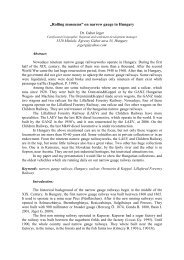'Representing Difficult Pasts within Complex Presents ... - T2M
'Representing Difficult Pasts within Complex Presents ... - T2M
'Representing Difficult Pasts within Complex Presents ... - T2M
You also want an ePaper? Increase the reach of your titles
YUMPU automatically turns print PDFs into web optimized ePapers that Google loves.
the Gold Reef City <strong>Complex</strong> as a whole… the Apartheid Museum is one of a range of attractions…. For<br />
those investing large money in the new entertainment business, reliving apartheid is another legitimate<br />
experience, an attraction, not quite a snuff movie, but in the same league’ (Hall and Bombardella 2005).<br />
For others, it is a successful and powerful reminder of a recent past and its exhibition methods succeed in<br />
conveying a traumatic and exploitative past (Ranking and Schmidt 2009).<br />
The museum, according to curator (Education and Exhibitions Consultant) Emilia Potenza,<br />
depicts the more the overriding ‘grand narrative’ of apartheid, including the history of resistance, rather<br />
than the individualized and ‘community’ experience of the District Six Museum 37 . In relation to vehicles,<br />
the museum contained ‘Mandela’s car’, created for him by transport workers after his release, and a type<br />
of vehicle not present in the James Hall Museum - a kaspir – representing an ominous feature of the<br />
apartheid past, which one could climb inside and look out from, to create a sense of understanding of<br />
apartheid surveillance and control.<br />
Two of the most successful exhibits of the Apartheid Museum, according to the curator Emilia<br />
Potenza in interview, were two displays where embodied experience played a major factor. As previously<br />
mentioned, the museum integrated architecture and design to create separate ‘black’ and ‘white’<br />
exhibition entrances, claimed by some to act as a bodily destabilizing experience, mimicking experiences<br />
of control, oppression, surveillance, segregation and liberation in its efforts to convey the experience of<br />
apartheid in the past (Rankin and Schmidt 2009). The second was a room that represented those who died<br />
from hanging, convicted as a result of apartheid resistance – an installation of hangman’s ropes- one for<br />
every person who died. Of note, according to the curator, was the effectiveness of the embodied<br />
experience of actually standing in the presence of an installation, or the body being made to move in<br />
certain ways.<br />
Discussion – A Plurality of Representations?<br />
26<br />
Transport and mobility as an exhibition theme suggest an in-between state, somewhere between<br />
artefact and movement. If one were to move away from merely depicting vehicles as objects to instead<br />
explore the thicker contextual world/s people moved – and in many cases, continue to move – <strong>within</strong>, in<br />
relation to the establishment of networks, divisions, linkages, access and non-mobilities, to unpack the<br />
spaces in-between ‘here’ and ‘there’, maybe there is an opportunity to interrogate, even break down, some<br />
of the constructedness of divided identities and communities in South Africa. Certainly, on an<br />
37 There are some memory boxes at the entrance, but the Apartheid museum focuses less on community and<br />
people stories overall, nothing like the scale of District Six museum.




